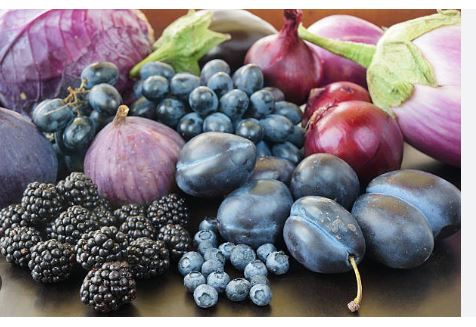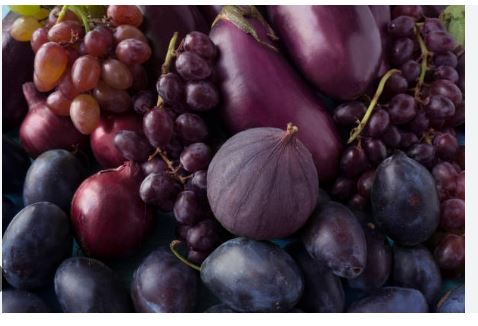
Purple fruits and vegetables owe their striking color to anthocyanins, powerful antioxidants that give them a vibrant hue. These compounds are more than just eye-catching—they’re linked to health benefits like reducing inflammation and supporting heart health. The deep shades signal a high concentration of nutrients, making these foods a smart addition to any diet.
Beyond their visual appeal, these foods pack a nutritional punch. They’re often rich in vitamins like C and K, as well as fiber, which aids digestion and promotes fullness. Some even contain unique compounds that may boost brain function or help regulate blood sugar, offering a range of wellness perks in every bite.
In the kitchen, their versatility shines. Whether eaten raw, roasted, or blended into dishes, they add both flavor and a pop of color. Their natural sweetness or earthiness complements everything from savory meals to desserts, making it easy to incorporate them into daily eating habits.
Culturally and historically, these foods have fascinated people for centuries, appearing in ancient cuisines and modern health trends alike. Their vivid tones have inspired everything from folklore to food art, cementing their place as both a nutritional and aesthetic treasure in diets worldwide.

Purple Fruits And Vegetables
Blackberries
- Description: Small, juicy, deep purple-black berries that grow in clusters on thorny bushes. They have a sweet-tart flavor.
- Nutritional Benefits: Rich in vitamins C and K, fiber, and manganese. Blackberries are high in anthocyanins, which may reduce inflammation and protect against chronic conditions like diabetes and cancer. They also contain ellagic acid, noted for antiviral and antibacterial properties.
- Culinary Uses: Perfect for smoothies, jams, pies, or fresh snacking. Toss into salads or yogurt for a nutrient boost.
Purple Grapes
- Description: Round, juicy fruits with thick, deep purple skin, often seedless (e.g., Concord grapes). They range from sweet to slightly tart.
- Nutritional Benefits: Packed with vitamins C and K, and resveratrol, an antioxidant linked to heart health and potential neuroprotection. Their anthocyanins may help prevent cancer cell growth and reduce cholesterol.
- Culinary Uses: Eaten fresh, dried as raisins, or used in juices, wines, and jellies. Add to cheese boards or fruit salads.
Plums
- Description: Oval fruits with smooth, purple skin and juicy flesh surrounding a single pit. Flavors range from sweet to tart.
- Nutritional Benefits: High in vitamins A, C, and K, plus fiber and polyphenols that combat inflammation and support blood sugar control. Plums may also aid digestion and bone health.
- Culinary Uses: Enjoy fresh, dried as prunes, or in jams, sauces, and desserts like plum tarts. They pair well with savory dishes, like roasted meats.
Eggplant (Aubergine)
- Description: A glossy, deep purple fruit (botanically, though used as a vegetable) with spongy white flesh. Shapes vary from long to round.
- Nutritional Benefits: Low in calories, high in fiber, and contains nasunin, an anthocyanin that protects cells from oxidative stress. Also offers vitamins B6 and K, and magnesium.
- Culinary Uses: Grill, roast, or stew in dishes like ratatouille, baba ganoush, or eggplant parmesan. It absorbs flavors well in curries and stir-fries.
Purple Cabbage (Red Cabbage)
- Description: A cruciferous vegetable with tightly packed, vibrant purple leaves that are slightly peppery.
- Nutritional Benefits: Loaded with vitamins C and K, fiber, and anthocyanins that may reduce heart disease risk and inflammation. It has six to eight times more vitamin C than green cabbage.
- Culinary Uses: Use raw in slaws, salads, or pickled for vibrant color. Cook in stir-fries, soups, or braised dishes.
Blueberries
- Description: Small, round, blue-purple berries with a sweet, slightly tangy taste and tiny seeds.
- Nutritional Benefits: A superfood packed with vitamins C and K, fiber, and flavonoids like anthocyanins, linked to better cognitive function, heart health, and diabetes prevention.
- Culinary Uses: Blend into smoothies, bake into muffins or pies, or sprinkle over oatmeal and salads. Freeze for a cool snack.
Purple Sweet Potatoes
- Description: Tubers with purple skin and flesh (e.g., Okinawan or Stokes varieties), sweeter and denser than orange sweet potatoes.
- Nutritional Benefits: High in fiber, vitamins A and C, and anthocyanins that may boost immunity and reduce inflammation. They’re a staple in Okinawa, linked to longevity.
- Culinary Uses: Bake, mash, or roast for sides, fries, or desserts like pies and cakes. Their vibrant color elevates dishes visually.
Purple Carrots
- Description: Slender root vegetables with purple skin and sometimes orange cores, offering a crisp texture and mild sweetness.
- Nutritional Benefits: Rich in anthocyanins, beta-carotene (converted to vitamin A), and fiber. They support eye health, immunity, and may have anti-cancer properties.
- Culinary Uses: Roast, steam, or eat raw in salads for crunch. Juice them for a nutrient-packed drink or add to soups.
Acai Berries
- Description: Tiny, deep purple berries from South American palm trees, with an earthy, slightly tart flavor.
- Nutritional Benefits: Bursting with anthocyanins, fiber, and vitamins A, C, and E. They support heart health, cognitive function, and may reduce inflammation.
- Culinary Uses: Blend into smoothie bowls, juices, or desserts. Often sold frozen or powdered due to their perishability.
Purple Cauliflower
- Description: A cruciferous vegetable with vivid purple florets, milder and sweeter than white cauliflower.
- Nutritional Benefits: High in vitamins C and K, folate, fiber, and anthocyanins that may protect against chronic diseases. It’s also low in calories.
- Culinary Uses: Steam, roast, or mash for colorful sides. Use raw in salads or as a crudité for dips.
Figs
- Description: Soft, pear-shaped fruits with purple or black skin, sweet flesh, and edible seeds.
- Nutritional Benefits: Rich in fiber, potassium, calcium, and phenolic compounds (including anthocyanins) that rival blackberries in antioxidant power. They aid digestion and bone health.
- Culinary Uses: Eat fresh, dried, or in jams. Pair with cheese, nuts, or in salads, or bake into tarts and cakes.
Beets
- Description: Round root vegetables with brown skin and deep purple-red flesh, known for their earthy sweetness.
- Nutritional Benefits: Contain betalains (not anthocyanins), which have anti-inflammatory and detoxifying properties. High in folate, manganese, and nitrates that may lower blood pressure.
- Culinary Uses: Roast, boil, or pickle for salads, soups (like borscht), or smoothies. Their greens are edible too!
Purple Kale
- Description: A leafy green vegetable with deep purple stems and leaves, sometimes called “redbor” kale, with a slightly bitter, earthy flavor.
- Nutritional Benefits: Packed with vitamins A, C, and K, plus calcium, iron, and anthocyanins that support heart health and reduce inflammation. It’s also high in fiber, aiding digestion.
- Culinary Uses: Massage raw leaves for salads, blend into smoothies, or sauté with garlic for a side dish. Bake into crispy kale chips for a healthy snack.
Black Currants
- Description: Small, glossy, dark purple berries with a tart, slightly sweet taste, often grown in cooler climates.
- Nutritional Benefits: Exceptionally high in vitamin C (up to four times more than oranges per serving), anthocyanins, and gamma-linolenic acid (GLA), which may boost immunity and skin health.
- Culinary Uses: Use in jams, jellies, syrups, or desserts like sorbets. Popular in beverages like black currant cordial or tea.
Purple Asparagus
- Description: Slender, purple spears with a tender texture and sweeter flavor than green asparagus.
- Nutritional Benefits: Rich in anthocyanins, folate, and vitamins A, C, and E. It supports digestive health and may help regulate blood sugar due to its fiber content.
- Culinary Uses: Grill, steam, or roast lightly to preserve color and crunch. Add to salads, stir-fries, or serve with dips as an appetizer.
Passion Fruit (Purple Variety)
- Description: Round fruit with tough purple skin encasing juicy, seed-filled pulp that’s tart and aromatic.
- Nutritional Benefits: High in vitamins A and C, fiber, and antioxidants like anthocyanins and polyphenols, which may aid heart health and reduce oxidative stress.
- Culinary Uses: Scoop out pulp for smoothies, desserts like pavlova, or cocktails. Strain for juices or sauces to drizzle over yogurt.
Purple Bell Peppers
- Description: Glossy, blocky peppers with a deep purple hue, milder and sweeter than green bell peppers.
- Nutritional Benefits: Loaded with vitamins A and C, fiber, and anthocyanins that promote eye health and reduce inflammation. Lower in calories, great for weight management.
- Culinary Uses: Eat raw in salads, stuff with grains or meat, or roast for smoky sweetness in salsas and sauces.
Purple Mangosteen
- Description: Tropical fruit with a thick purple rind and soft, white, segmented flesh that’s sweet-tart and floral.
- Nutritional Benefits: Contains xanthones and anthocyanins, which may have anti-inflammatory and anti-cancer effects. High in fiber and vitamin C for immunity.
- Culinary Uses: Eat fresh by scooping out the flesh, or blend into smoothies and sorbets. The rind is inedible but sometimes used in teas.
Purple Corn
- Description: Ancient grain with deep purple kernels, used whole, ground, or as flour, with a nutty flavor.
- Nutritional Benefits: Rich in anthocyanins (higher than blueberries in some varieties), fiber, and complex carbs. May help reduce blood pressure and cholesterol.
- Culinary Uses: Grind into flour for tortillas, bake into breads, or boil for drinks like Peruvian chicha morada. Pop as popcorn for a colorful twist.
Elderberries
- Description: Tiny, dark purple berries growing in clusters, with a tart, earthy flavor, often cooked to be edible.
- Nutritional Benefits: High in vitamins C and A, fiber, and anthocyanins that boost immunity and may reduce cold and flu symptoms. Also contain antiviral compounds.
- Culinary Uses: Cook into syrups, jams, or wines. Use in pies or teas, but avoid raw berries due to mild toxicity.
Purple Tomatoes
- Description: Round or plum-shaped tomatoes with purple-black skin and reddish-purple flesh, sweeter than red varieties.
- Nutritional Benefits: Packed with anthocyanins, lycopene, and vitamins C and K, supporting heart health and potentially reducing cancer risk.
- Culinary Uses: Slice for salads, sandwiches, or caprese. Roast for sauces or salsas to deepen flavor and color.
Purple Beans (String Beans)
- Description: Long, slender pods that are deep purple when raw, with a crisp texture and mild flavor.
- Nutritional Benefits: High in fiber, vitamins A, C, and K, and anthocyanins that support heart and digestive health. Low in calories, great for balanced diets.
- Culinary Uses: Steam, sauté, or blanch for sides or salads. They turn green when cooked, so eat raw for color.
Purple Broccoli
- Description: A vibrant purple cousin of green broccoli, with smaller florets and a sweeter, milder taste.
- Nutritional Benefits: Rich in vitamins C and K, folate, fiber, and anthocyanins that may protect against cancer and heart disease. Also high in glucosinolates, linked to detoxification.
- Culinary Uses: Steam or roast lightly to retain color, or add raw to salads for crunch. Blend into soups for a nutrient boost.
Dragon Fruit (Purple-Fleshed Variety)
- Description: Oval fruit with pink-purple skin, green scales, and speckled purple flesh, mildly sweet with a kiwi-like texture.
- Nutritional Benefits: Contains anthocyanins, fiber, and vitamins C and E, supporting immunity and skin health. Its seeds provide healthy fats.
- Culinary Uses: Scoop out flesh for smoothies, sorbets, or fruit bowls. Cube for salads or freeze for popsicles.